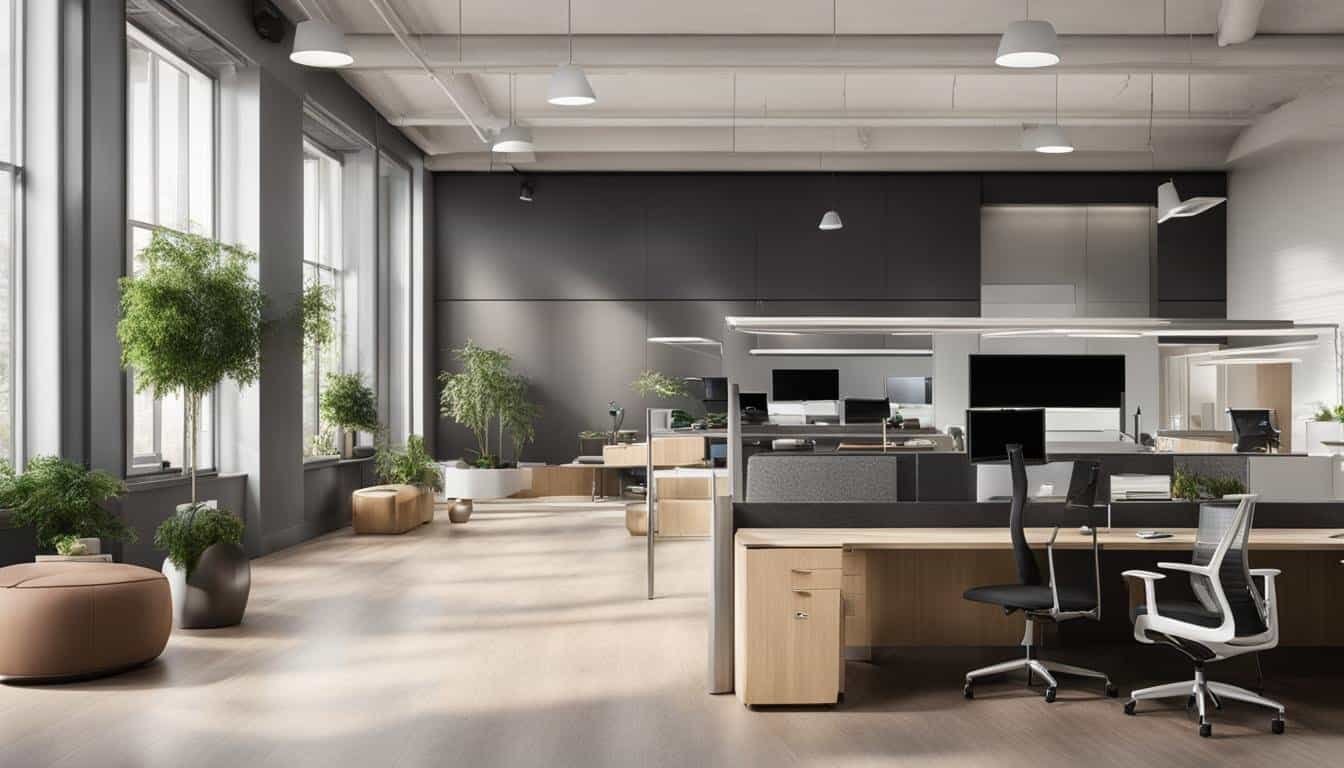Designing Workspaces for Hybrid Models: A 2024 Guide
Welcome to our guide on designing workspaces for hybrid models! As the world evolves, so does the way we work. With the rise of hybrid work environments, it’s crucial to create spaces that cater to the needs of a blended remote and in-office workforce. In this guide, we will explore the key elements of hybrid workspace design and provide valuable insights to help you optimize your office space for the future.
Key Takeaways:
- Understand the importance of creating flexible workspace solutions for a hybrid workforce.
- Optimize your office space by incorporating social, meet, focus, and balance spaces.
- Involve employees in the design process to ensure the workspace meets their needs.
- Explore the benefits of hybrid workplace software in managing a dynamic workforce.
- Enhance employee engagement, productivity, and well-being through thoughtful design.
What is Hybrid Office Design?
Hybrid office design is the strategic creation of office spaces that cater to the needs of a hybrid workforce. Combining remote and in-office work, this design approach aims to optimize employee engagement and productivity. It emphasizes the importance of creating social, meet, focus, and balance spaces within the office environment to ensure the well-being of employees.
Hybrid office design acknowledges the changing dynamics of work, accommodating both remote and in-office work arrangements. By integrating elements that support collaboration, communication, and individual focus, hybrid office design promotes a flexible and productive work environment.
The key components of hybrid office design are:
- Social spaces: These areas encourage interaction, collaboration, and community-building among employees.
- Meet spaces: Designed for in-person meetings, these areas facilitate effective collaboration, brainstorming, and sharing of ideas.
- Focus spaces: These spaces provide a quiet and distraction-free environment for individuals to concentrate and complete tasks.
- Balance spaces: Designed to support employee well-being, these spaces promote relaxation, rejuvenation, and work-life balance.
By incorporating these components into the office design, hybrid workspace solutions offer the flexibility and adaptability required in today’s evolving work landscape. They create an environment that fosters employee engagement, drives productivity, and enhances overall job satisfaction.
Next, let’s explore the process of building a hybrid office and the various factors to consider in creating a workspace that meets the needs of a hybrid workforce.
How do I build a hybrid office?
When it comes to creating a successful hybrid office, research shows that offering a variety of spaces is key to driving employee engagement. Incorporating social, meet, focus, and balance spaces in the office environment fosters casual interactions, community-building, collaboration, and concentration. By providing these diverse spaces, you can cater to different work styles and needs, resulting in a more productive and satisfied workforce.
To build a hybrid office that promotes employee engagement, consider the following:
1. Incorporate Social Spaces
Social spaces, such as lounges or pantries, play a crucial role in creating a sense of community in the office. They provide opportunities for casual collisions and spontaneous conversations, fostering connections among colleagues. These spaces encourage collaboration, innovation, and the exchange of ideas, ultimately enhancing employee engagement.
2. Create Meet Spaces
Meeting spaces are essential for in-person collaboration and building trust among team members. Design areas dedicated to sharing and learning, collaboration, brainstorming, conversing, and connecting. These spaces should be equipped with the necessary tools and technology to facilitate effective and productive meetings, ensuring that employees can collaborate seamlessly between remote and in-office work.
3. Design Focus Spaces
In a hybrid office, it’s crucial to provide dedicated spaces for focused work. Consider incorporating flexible or hot desks that allow employees to choose their preferred work environment. Create quiet areas where individuals can concentrate without distractions, whether they prefer open yet quiet spaces or completely enclosed areas. Providing a variety of focus spaces ensures that employees have the autonomy to work in a way that suits their needs.
4. Prioritize Balance Spaces
Balancing work and personal well-being is essential for employee satisfaction and overall productivity. Design spaces that promote employee well-being, such as sleep areas for rest and rejuvenation. Consider incorporating elements like natural light, ergonomic furniture, and soothing environmental factors to enhance physical well-being. Additionally, create spaces that support psychological well-being, stress management, and mental health.
When building a hybrid office, involving employees in the design process is crucial. Employee input ensures that the office environment meets their needs and fosters a sense of belonging. By creating a variety of spaces that cater to different work styles and preferences, you can optimize your office environment and enhance employee engagement and productivity.
In the next section, we will explore the importance of social spaces in a hybrid office and how they contribute to employee engagement and collaboration.
Social Spaces in a Hybrid Office
Social spaces are essential in creating a vibrant and inclusive work environment for your hybrid office. These spaces provide opportunities for employees to connect with one another, fostering a sense of community and collaboration. Incorporating various social spaces in your office design can significantly enhance employee engagement, innovation, and overall productivity.
The Role of Social Spaces
Social spaces serve as hubs for spontaneous interactions and informal discussions, allowing employees to exchange ideas, seek advice, and build relationships. These spaces provide a break from formal work settings and encourage a more relaxed and open atmosphere.
“Social interaction is the foundation of collaboration and innovation. By creating inviting social spaces, you can inspire creativity and foster a sense of belonging among your hybrid workforce.” – Workspace Design Expert
Types of Social Spaces
Here are some examples of social spaces that you can integrate into your hybrid office:
- Community Spaces: Dedicated areas where employees can gather for team-building activities, workshops, or informal meetings.
- Lounges: Comfortable seating areas designed for relaxation, casual conversations, and impromptu collaborations.
- Pantries/Kitchens: Well-equipped spaces where employees can socialize while enjoying snacks or meals.
- Coffee Shops: Cafeteria-style spaces with beverage stations and cozy seating arrangements, mimicking the ambiance of a local coffee shop.
- Gardens: Indoor or outdoor green spaces that provide a serene environment for employees to connect with nature and recharge.
- Play Areas: Fun zones equipped with games, toys, or recreational activities that allow employees to unwind and bond during breaks.
By incorporating a mix of these social spaces, you create an inclusive atmosphere that encourages collaboration, increases employee satisfaction, and boosts overall productivity.
| Benefits of Social Spaces in a Hybrid Office | Examples |
|---|---|
| Promotes spontaneous interactions and informal collaboration | Lounges, coffee shops |
| Enhances employee engagement and sense of belonging | Community spaces, play areas |
| Fosters creativity, innovation, and the exchange of ideas | Gardens, pantries/kitchens |
The table above highlights some of the benefits of incorporating social spaces into your hybrid office and provides examples of the different types of social spaces available.
Creating inviting social spaces in your hybrid office not only improves employee well-being but also strengthens team dynamics and boosts overall company culture. Investing in these spaces can have a profound impact on your organizational success.
Meet Spaces in a Hybrid Office
In a hybrid office, meet spaces are essential for fostering in-person collaboration, communication, and building trust among team members. These spaces provide an opportunity for employees to connect and work together, facilitating seamless knowledge sharing, brainstorming, and innovation. Let’s explore different types of meet spaces that can enhance productivity and strengthen collaboration in a hybrid work environment.
Share & Learn Spaces
Share & learn spaces are ideal for presentations, training sessions, and workshops. Equipped with necessary technology and audiovisual aids, these spaces enable teams to share their expertise, exchange knowledge, and learn from one another. Whether it’s a product launch, a critical project update, or a training session, these spaces encourage engaging interactions, fostering a culture of continuous learning and growth.
Collaborate Spaces
Collaborate spaces provide the necessary infrastructure for teams to work together on projects, campaigns, or problem-solving activities. Equipped with large screens, interactive whiteboards, and collaborative tools, these spaces facilitate effective teamwork, enabling team members to brainstorm ideas, visualize concepts, and make informed decisions. Collaboration spaces encourage creativity, foster efficient communication, and drive innovation.
Brainstorm & Innovate Spaces
Brainstorm & innovate spaces are designed to inspire creativity and innovative thinking. These spaces often feature comfortable furniture, whiteboards, and other tools that encourage individuals or teams to generate ideas freely. Whether it’s ideation sessions, design thinking workshops, or strategic planning, these spaces create an environment conducive to out-of-the-box thinking, sparking creativity, and driving innovation.
Converse Spaces
Converse spaces are small group discussion areas where team members can have focused conversations and exchange ideas. These spaces are ideal for collaboration among smaller teams or departments, fostering effective communication and collaboration. Whether it’s a quick catch-up, a project update, or a brainstorming session, converse spaces enable meaningful interactions and collaboration among team members.
Connect Spaces
Connect spaces provide an environment for one-on-one conversations, whether it’s for mentorship, coaching, feedback, or casual networking. These spaces can be small meeting rooms, comfortable seating areas, or even designated coffee corners. Connect spaces facilitate personal connections, enabling team members to develop stronger relationships, support each other, and enhance overall collaboration within the organization.
By incorporating a variety of meet spaces in a hybrid office, organizations can create meaningful opportunities for face-to-face interaction, fostering teamwork, and driving innovation. These spaces play a crucial role in building a collaborative work culture, cultivating employee engagement, and driving overall productivity.
| Meet Spaces in a Hybrid Office | Benefits |
|---|---|
| Share & Learn Spaces | Facilitate knowledge sharing and continuous learning |
| Collaborate Spaces | Enhance teamwork, communication, and decision-making |
| Brainstorm & Innovate Spaces | Spark creativity, drive innovation, and generate new ideas |
| Converse Spaces | Promote focused conversations and collaboration among smaller groups |
| Connect Spaces | Facilitate one-on-one interactions, mentorship, and networking |
Focus Spaces in a Hybrid Office
In a hybrid office, it is essential to provide dedicated focus spaces where employees can concentrate on their work without distractions. These focus spaces play a crucial role in maintaining productivity and allowing individuals to complete tasks efficiently.
One effective way to optimize focus spaces is by incorporating flexible or hot desks. These workstations can be utilized by employees on an as-needed basis, ensuring that workspaces are not left unused. Flexibility in desk arrangements allows individuals to choose an environment that best suits their focus needs.
Creating quiet areas within the office is another key aspect of focus space design. These areas provide employees with a peaceful environment where they can work without interruptions. Quiet areas can be designated zones or separate rooms, equipped with comfortable seating and minimal noise levels.
Open Yet Quiet Areas
An innovative approach to focus space design is the concept of open yet quiet areas. These spaces strike a balance between fostering a collaborative atmosphere while still providing a peaceful environment for focused work. Open yet quiet areas can be designed with partitions, acoustic panels, or spatial arrangements that minimize distractions while maintaining an open layout.
Creating dedicated focus spaces is crucial in a hybrid office. By providing flexible or hot desks, quiet areas, and open yet quiet areas, employees can choose an environment that enhances their concentration and productivity.
It is important to consider the specific needs and preferences of employees when designing focus spaces. Some individuals may prefer complete silence, while others may benefit from background noise or white noise options. By catering to diverse focus requirements, you can create an office environment that supports the well-being and productivity of all employees.
Take a look at the table below for a comprehensive overview of focus spaces in a hybrid office:
| Focus Spaces | Features |
|---|---|
| Flexible or Hot Desks | Workstations that can be easily adjusted and utilized based on individual needs |
| Quiet Areas | Dedicated zones or rooms with minimized noise levels for concentrated work |
| Open Yet Quiet Areas | Spaces that balance collaboration and focus through clever design and noise control techniques |
To further illustrate the concept, here’s an image showcasing a focus space in a hybrid office:
By strategically incorporating these focus spaces into the office layout, you can provide employees with the environments they need to stay focused and accomplish their tasks efficiently.
Balance Spaces in a Hybrid Office
Creating balance spaces in a hybrid office is crucial for fostering employee wellbeing and promoting work-life balance. These spaces are designed to address the physical, environmental, and psychological needs of employees, ensuring their overall health and productivity.
1. Sleep Spaces
One important aspect of balance spaces is providing sleep spaces where employees can rest and rejuvenate. These dedicated areas enable employees to recharge during long working hours, helping them maintain optimal performance and reduce fatigue. Sleep spaces can include cozy nap pods or comfortable recliners that offer a peaceful environment for short power naps.
2. Well-designed Lighting and Environmental Factors
Lighting plays a crucial role in employee wellbeing and productivity. Natural light and adjustable lighting options can enhance focus, reduce eye strain, and improve mood. Additionally, incorporating greenery and other elements of biophilic design can contribute to a healthier and more refreshing office environment, boosting physical and mental well-being.
3. Spaces for Psychological Well-being and Stress Management
Creating spaces that promote psychological well-being and stress management is essential for employees’ mental health. These spaces can be designed to provide tranquility, privacy, and peace of mind. Examples include meditation rooms, quiet corners, or comfortable seating areas where employees can find solace, unwind, and practice mindfulness techniques.
Incorporating balance spaces in a hybrid office not only meets the diverse needs of employees but also fosters a positive work environment that prioritizes their overall wellness. It enhances employee engagement, improves job satisfaction, and boosts productivity.
Providing balance spaces in a hybrid office is not only a thoughtful investment in employee wellbeing but also an effective strategy for creating a harmonious work-life balance.
| Benefits of Balance Spaces |
|---|
| Promotes employee wellbeing |
| Enhances work-life balance |
| Reduces stress and fatigue |
| Boosts productivity and engagement |
Importance of Hybrid Workplace Software
Hybrid work environments bring together the best of both worlds, combining remote work and in-office collaboration. To facilitate the seamless integration of these two work modes, adaptable work environments and efficient resource management are essential. This is where hybrid workplace software comes into play, offering a range of tools designed to optimize the hybrid work experience.
One of the key advantages of hybrid workplace software is its ability to manage the complexities of a hybrid work environment. It provides real-time insights into workspace utilization, helping organizations make informed decisions about office space allocation and layout. With efficient resource management, companies can maximize their workspace efficiency, ensuring that resources are utilized optimally for both remote and in-office employees.
Efficient communication is another crucial aspect of hybrid work environments. Hybrid workplace software offers a variety of communication tools that enable seamless collaboration across geographically dispersed teams. From video conferencing platforms to instant messaging apps, these tools ensure that employees can connect and collaborate effectively, regardless of their physical location.
The connection between a dynamic workforce and physical spaces is equally important in hybrid work environments. Hybrid workplace software facilitates this connection by providing integration with other software and systems. For example, it may synchronize with office booking systems, allowing employees to reserve workspace in advance and ensure a smooth transition between remote work and in-office collaborations.
To illustrate the importance of hybrid workplace software, consider the following table showcasing the key features and benefits of popular hybrid workplace software solutions:
| Hybrid Workplace Software | Key Features | Benefits |
|---|---|---|
| 1. Microsoft Teams | – Video conferencing – Instant messaging – File sharing and collaboration – Integration with other Microsoft tools |
– Seamless collaboration across remote and in-office teams – Centralized communication and document management – Enhanced productivity and efficiency |
| 2. Slack | – Channel-based communication – File sharing and collaboration – Integration with popular tools and services – Advanced search functionality |
– Efficient team collaboration and information sharing – Streamlined communication across departments – Easy access to important documents and conversations |
| 3. Asana | – Project and task management – Team collaboration and communication – Progress tracking and reporting – Integration with various productivity tools |
– Effective project planning and execution – Transparent task management and accountability – Improved team coordination and productivity |
By utilizing hybrid workplace software, organizations can create a cohesive, efficient, and productive work environment that caters to both remote and in-office employees. These software solutions play a crucial role in adapting to the evolving needs of hybrid work models, enabling effective communication, seamless resource management, and dynamic collaboration.
Conclusion
Designing workspaces for hybrid models is crucial for optimizing office spaces and enhancing employee engagement, productivity, and well-being. By incorporating social, meet, focus, and balance spaces, you can create a flexible and collaborative environment that caters to the needs of your hybrid workforce.
However, to effectively manage the challenges of a dynamic workforce, it is essential to leverage hybrid workspace software. This innovative technology enables efficient resource management and seamless communication among teams, ensuring a smooth workflow and maximizing productivity.
By prioritizing the design of your office spaces and utilizing hybrid workspace software, you can create an environment that not only supports the hybrid work model but also fosters employee well-being. This holistic approach to workspace design will not only optimize the utilization of your office spaces but also enhance employee satisfaction, engagement, and overall work experience.






